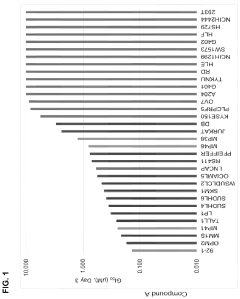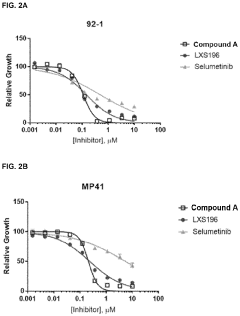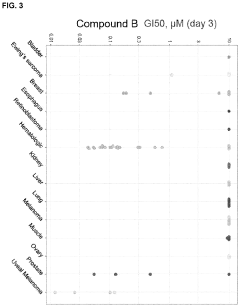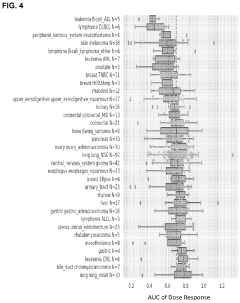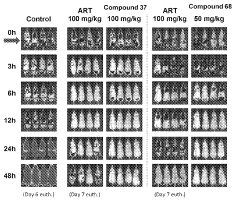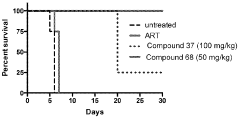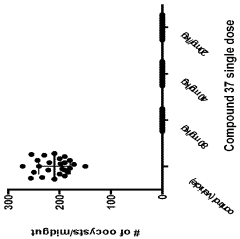Exploration of Reaction Mechanisms Involving Geometric Isomers
AUG 1, 20259 MIN READ
Generate Your Research Report Instantly with AI Agent
Patsnap Eureka helps you evaluate technical feasibility & market potential.
Geometric Isomerism Background and Research Objectives
Geometric isomerism, a fundamental concept in organic chemistry, has been a subject of scientific inquiry for over a century. This phenomenon occurs when molecules have the same molecular formula but different spatial arrangements of atoms, leading to distinct physical and chemical properties. The study of geometric isomers has evolved significantly since its initial discovery in the late 19th century, with major advancements in understanding their structure, behavior, and reactivity.
The exploration of reaction mechanisms involving geometric isomers has gained increasing importance in recent decades due to its wide-ranging applications in pharmaceuticals, materials science, and biochemistry. Geometric isomers play crucial roles in biological systems, influencing the efficacy of drugs, the properties of polymers, and the function of natural compounds. As such, a comprehensive understanding of their reaction mechanisms is essential for advancing various fields of science and technology.
The primary objective of this research is to elucidate the intricate reaction mechanisms that govern the behavior of geometric isomers. This includes investigating the factors that influence isomerization processes, such as temperature, light, catalysts, and solvent effects. By gaining deeper insights into these mechanisms, researchers aim to develop more efficient and selective methods for synthesizing specific isomers, as well as to predict and control their reactivity in complex chemical systems.
Another key goal is to explore the relationship between the geometric structure of isomers and their reactivity. This involves studying how subtle differences in spatial arrangement can lead to significant variations in reaction rates, product distributions, and stereochemical outcomes. Understanding these structure-reactivity relationships is crucial for designing new molecules with tailored properties and for optimizing existing chemical processes.
Furthermore, this research seeks to investigate the role of geometric isomerism in natural systems, particularly in biological processes. This includes examining how enzymes distinguish between different geometric isomers and how isomerization events contribute to the regulation of cellular functions. By unraveling these mechanisms, scientists hope to gain new insights into the molecular basis of life and potentially develop novel therapeutic approaches.
The exploration of reaction mechanisms involving geometric isomers also aims to advance analytical techniques for identifying and characterizing these compounds. This includes developing more sensitive and accurate methods for detecting and quantifying geometric isomers in complex mixtures, as well as improving computational models for predicting their behavior and properties.
Ultimately, this research endeavors to bridge the gap between fundamental chemical principles and practical applications, paving the way for innovations in drug discovery, materials design, and sustainable chemistry. By deepening our understanding of geometric isomerism and its associated reaction mechanisms, we can unlock new possibilities for creating more efficient, selective, and environmentally friendly chemical processes.
The exploration of reaction mechanisms involving geometric isomers has gained increasing importance in recent decades due to its wide-ranging applications in pharmaceuticals, materials science, and biochemistry. Geometric isomers play crucial roles in biological systems, influencing the efficacy of drugs, the properties of polymers, and the function of natural compounds. As such, a comprehensive understanding of their reaction mechanisms is essential for advancing various fields of science and technology.
The primary objective of this research is to elucidate the intricate reaction mechanisms that govern the behavior of geometric isomers. This includes investigating the factors that influence isomerization processes, such as temperature, light, catalysts, and solvent effects. By gaining deeper insights into these mechanisms, researchers aim to develop more efficient and selective methods for synthesizing specific isomers, as well as to predict and control their reactivity in complex chemical systems.
Another key goal is to explore the relationship between the geometric structure of isomers and their reactivity. This involves studying how subtle differences in spatial arrangement can lead to significant variations in reaction rates, product distributions, and stereochemical outcomes. Understanding these structure-reactivity relationships is crucial for designing new molecules with tailored properties and for optimizing existing chemical processes.
Furthermore, this research seeks to investigate the role of geometric isomerism in natural systems, particularly in biological processes. This includes examining how enzymes distinguish between different geometric isomers and how isomerization events contribute to the regulation of cellular functions. By unraveling these mechanisms, scientists hope to gain new insights into the molecular basis of life and potentially develop novel therapeutic approaches.
The exploration of reaction mechanisms involving geometric isomers also aims to advance analytical techniques for identifying and characterizing these compounds. This includes developing more sensitive and accurate methods for detecting and quantifying geometric isomers in complex mixtures, as well as improving computational models for predicting their behavior and properties.
Ultimately, this research endeavors to bridge the gap between fundamental chemical principles and practical applications, paving the way for innovations in drug discovery, materials design, and sustainable chemistry. By deepening our understanding of geometric isomerism and its associated reaction mechanisms, we can unlock new possibilities for creating more efficient, selective, and environmentally friendly chemical processes.
Market Analysis for Geometric Isomer Applications
The market for geometric isomer applications has been experiencing significant growth in recent years, driven by advancements in chemical synthesis, pharmaceutical development, and materials science. Geometric isomers, which are molecules with the same molecular formula but different spatial arrangements of atoms, play a crucial role in various industries, particularly in drug development and agrochemicals.
In the pharmaceutical sector, geometric isomers have become increasingly important due to their impact on drug efficacy and safety. Many drugs exist as geometric isomers, with one form often being more therapeutically active than the other. This has led to a growing demand for methods to selectively produce and isolate specific isomers. The market for chiral drugs, which includes geometric isomers, has been expanding rapidly, with estimates suggesting it accounts for a substantial portion of the global pharmaceutical market.
The agrochemical industry also relies heavily on geometric isomers for the development of more effective and environmentally friendly pesticides and herbicides. The ability to control the spatial arrangement of molecules can lead to improved target specificity and reduced environmental impact, driving demand for isomer-specific products in this sector.
In the field of materials science, geometric isomers are finding applications in the development of advanced polymers and liquid crystals. These materials have unique properties that can be tailored by controlling the isomeric composition, opening up new possibilities in electronics, optics, and smart materials.
The market for analytical tools and techniques to study and manipulate geometric isomers is also expanding. This includes advanced spectroscopic methods, chromatography techniques, and computational tools for predicting and analyzing isomeric structures. As research in this area intensifies, the demand for specialized equipment and software is expected to grow.
Geographically, North America and Europe currently dominate the market for geometric isomer applications, primarily due to their strong pharmaceutical and chemical industries. However, Asia-Pacific is emerging as a rapidly growing market, driven by increasing investments in research and development, particularly in countries like China, Japan, and India.
The exploration of reaction mechanisms involving geometric isomers is likely to fuel further market growth. As researchers gain a deeper understanding of the factors controlling isomerization processes, new opportunities for selective synthesis and applications are expected to emerge. This could lead to the development of more efficient catalysts, novel synthetic routes, and innovative products across multiple industries.
In the pharmaceutical sector, geometric isomers have become increasingly important due to their impact on drug efficacy and safety. Many drugs exist as geometric isomers, with one form often being more therapeutically active than the other. This has led to a growing demand for methods to selectively produce and isolate specific isomers. The market for chiral drugs, which includes geometric isomers, has been expanding rapidly, with estimates suggesting it accounts for a substantial portion of the global pharmaceutical market.
The agrochemical industry also relies heavily on geometric isomers for the development of more effective and environmentally friendly pesticides and herbicides. The ability to control the spatial arrangement of molecules can lead to improved target specificity and reduced environmental impact, driving demand for isomer-specific products in this sector.
In the field of materials science, geometric isomers are finding applications in the development of advanced polymers and liquid crystals. These materials have unique properties that can be tailored by controlling the isomeric composition, opening up new possibilities in electronics, optics, and smart materials.
The market for analytical tools and techniques to study and manipulate geometric isomers is also expanding. This includes advanced spectroscopic methods, chromatography techniques, and computational tools for predicting and analyzing isomeric structures. As research in this area intensifies, the demand for specialized equipment and software is expected to grow.
Geographically, North America and Europe currently dominate the market for geometric isomer applications, primarily due to their strong pharmaceutical and chemical industries. However, Asia-Pacific is emerging as a rapidly growing market, driven by increasing investments in research and development, particularly in countries like China, Japan, and India.
The exploration of reaction mechanisms involving geometric isomers is likely to fuel further market growth. As researchers gain a deeper understanding of the factors controlling isomerization processes, new opportunities for selective synthesis and applications are expected to emerge. This could lead to the development of more efficient catalysts, novel synthetic routes, and innovative products across multiple industries.
Current Challenges in Geometric Isomer Reaction Mechanisms
The exploration of reaction mechanisms involving geometric isomers faces several significant challenges in contemporary research. One of the primary obstacles is the complexity of conformational changes during reactions. Geometric isomers can undergo intricate transformations, making it difficult to track and predict reaction pathways accurately. This complexity is further compounded by the influence of environmental factors, such as solvent effects and temperature, which can dramatically alter the behavior of geometric isomers.
Another major challenge lies in the detection and characterization of short-lived intermediates. Many reaction mechanisms involving geometric isomers proceed through transient species that exist for only fractions of a second. Capturing and analyzing these fleeting intermediates requires advanced spectroscopic techniques and sophisticated computational models, which are not always readily available or fully developed.
The issue of stereoselectivity presents yet another hurdle in understanding geometric isomer reactions. Controlling the stereochemical outcome of reactions involving geometric isomers is crucial for many applications, particularly in pharmaceutical synthesis. However, achieving high levels of stereoselectivity often requires a deep understanding of the subtle factors influencing isomer interconversion and reaction kinetics.
Energy barriers and transition states pose significant challenges in elucidating reaction mechanisms. The energy landscape for geometric isomer transformations can be complex, with multiple possible pathways and transition states. Accurately calculating and experimentally verifying these energy profiles remains a formidable task, especially for larger, more complex molecules.
Catalysis in geometric isomer reactions introduces additional layers of complexity. While catalysts can offer new reaction pathways and enhanced selectivity, they also complicate the mechanistic picture. Understanding the interplay between catalysts and geometric isomers, including how catalysts influence isomerization rates and product distributions, is an ongoing challenge in the field.
Lastly, the integration of experimental data with theoretical predictions remains a significant challenge. While computational chemistry has made great strides in modeling geometric isomer reactions, reconciling theoretical models with experimental observations is not always straightforward. Bridging this gap requires a multidisciplinary approach, combining advanced experimental techniques with sophisticated computational methods.
Another major challenge lies in the detection and characterization of short-lived intermediates. Many reaction mechanisms involving geometric isomers proceed through transient species that exist for only fractions of a second. Capturing and analyzing these fleeting intermediates requires advanced spectroscopic techniques and sophisticated computational models, which are not always readily available or fully developed.
The issue of stereoselectivity presents yet another hurdle in understanding geometric isomer reactions. Controlling the stereochemical outcome of reactions involving geometric isomers is crucial for many applications, particularly in pharmaceutical synthesis. However, achieving high levels of stereoselectivity often requires a deep understanding of the subtle factors influencing isomer interconversion and reaction kinetics.
Energy barriers and transition states pose significant challenges in elucidating reaction mechanisms. The energy landscape for geometric isomer transformations can be complex, with multiple possible pathways and transition states. Accurately calculating and experimentally verifying these energy profiles remains a formidable task, especially for larger, more complex molecules.
Catalysis in geometric isomer reactions introduces additional layers of complexity. While catalysts can offer new reaction pathways and enhanced selectivity, they also complicate the mechanistic picture. Understanding the interplay between catalysts and geometric isomers, including how catalysts influence isomerization rates and product distributions, is an ongoing challenge in the field.
Lastly, the integration of experimental data with theoretical predictions remains a significant challenge. While computational chemistry has made great strides in modeling geometric isomer reactions, reconciling theoretical models with experimental observations is not always straightforward. Bridging this gap requires a multidisciplinary approach, combining advanced experimental techniques with sophisticated computational methods.
Existing Methodologies for Studying Geometric Isomers
01 Synthesis and separation of geometric isomers
Methods for synthesizing and separating geometric isomers, including techniques for controlling the formation of specific isomers during chemical reactions and purification processes to isolate desired isomers from mixtures.- Synthesis and separation of geometric isomers: Methods for synthesizing and separating geometric isomers, including techniques for controlling the formation of specific isomers during chemical reactions and processes for isolating desired isomers from mixtures. These methods may involve catalysts, reaction conditions, or separation techniques such as chromatography.
- Geometric isomers in pharmaceutical compounds: The importance of geometric isomers in pharmaceutical compounds, including their effects on drug efficacy, safety, and pharmacokinetics. This includes methods for designing and synthesizing specific geometric isomers of drug molecules to optimize their therapeutic properties.
- Analytical methods for identifying geometric isomers: Techniques for identifying and characterizing geometric isomers, including spectroscopic methods such as NMR, IR, and X-ray crystallography. These methods allow for the determination of molecular structure and the differentiation between geometric isomers in complex mixtures.
- Geometric isomers in materials science and engineering: Applications of geometric isomers in materials science and engineering, including their use in developing novel materials with specific properties. This may involve the design of polymers, liquid crystals, or other functional materials where the geometric arrangement of molecules plays a crucial role in determining material properties.
- Computational modeling of geometric isomers: The use of computational methods to model and predict the properties of geometric isomers. This includes quantum chemical calculations, molecular dynamics simulations, and machine learning approaches to understand the relationship between molecular structure and properties of geometric isomers.
02 Characterization and analysis of geometric isomers
Techniques for identifying and analyzing geometric isomers, including spectroscopic methods, chromatography, and computational approaches to determine the structure and properties of different isomeric forms.Expand Specific Solutions03 Applications of geometric isomers in pharmaceuticals
Utilization of geometric isomers in drug development and formulation, focusing on the different biological activities and therapeutic effects of various isomeric forms of pharmaceutical compounds.Expand Specific Solutions04 Geometric isomers in materials science and engineering
Exploration of the role of geometric isomers in materials science, including their impact on physical properties, optical characteristics, and potential applications in advanced materials and devices.Expand Specific Solutions05 Computational modeling and visualization of geometric isomers
Development of computational tools and algorithms for modeling, simulating, and visualizing geometric isomers, aiding in the understanding of their structural relationships and properties.Expand Specific Solutions
Key Research Institutions and Industry Players
The exploration of reaction mechanisms involving geometric isomers is currently in a developing stage, with growing interest from both academia and industry. The market size for this research area is expanding, driven by its potential applications in pharmaceuticals, materials science, and chemical engineering. Technologically, the field is progressing rapidly, with companies like Pfizer Inc., Novartis AG, and AbbVie, Inc. investing in advanced analytical techniques and computational modeling to understand these complex mechanisms. The Scripps Research Institute and The Broad Institute, Inc. are also making significant contributions, pushing the boundaries of knowledge in this domain. While not yet fully mature, the technology is advancing steadily, with promising implications for drug discovery and development.
Pfizer Inc.
Technical Solution: Pfizer has developed a comprehensive approach to exploring reaction mechanisms involving geometric isomers. Their method combines advanced computational modeling with high-throughput experimentation. They utilize density functional theory (DFT) calculations to predict reaction pathways and energy barriers for different isomeric transitions[1]. This is complemented by rapid screening of reaction conditions using automated microfluidic systems, allowing for the exploration of a wide parameter space[3]. Pfizer has also implemented in situ spectroscopic techniques, such as time-resolved IR and Raman spectroscopy, to monitor isomerization processes in real-time[5]. This multi-faceted approach enables Pfizer to elucidate complex reaction mechanisms and optimize synthetic routes for pharmaceutically relevant compounds.
Strengths: Comprehensive integration of computational and experimental techniques; High-throughput capabilities for rapid mechanism elucidation. Weaknesses: High cost of advanced instrumentation; Complexity in data interpretation from multiple sources.
The Scripps Research Institute
Technical Solution: The Scripps Research Institute has pioneered innovative approaches to studying reaction mechanisms involving geometric isomers. They have developed a novel single-molecule fluorescence resonance energy transfer (smFRET) technique to directly observe isomerization events in real-time[2]. This method allows for the visualization of individual molecule conformational changes, providing unprecedented insights into reaction dynamics. Additionally, Scripps researchers have employed advanced NMR spectroscopy techniques, including NOESY and ROESY experiments, to characterize the three-dimensional structures of geometric isomers and their transition states[4]. They have also utilized ultrafast laser spectroscopy to probe the femtosecond-scale dynamics of isomerization reactions, revealing key mechanistic details of photochemical processes[6]. These cutting-edge techniques have been applied to a range of systems, from small organic molecules to complex biomolecules, advancing our understanding of isomerization mechanisms across multiple fields.
Strengths: Cutting-edge single-molecule techniques; Broad applicability from small molecules to biomolecules. Weaknesses: Highly specialized equipment required; Challenges in scaling up to bulk reactions.
Breakthrough Technologies in Isomer Reaction Analysis
Compounds and uses thereof
PatentPendingUS20230145003A1
Innovation
- Development of specific compounds that modulate the BAF complex by inhibiting BRG1 and/or BRM activity, which can be used alone or in combination with other pharmaceutically active agents to treat disorders like cancer.
Compounds and methods for the treatment of malaria
PatentInactiveIN202118043692A
Innovation
- Development of specific compounds, such as those represented by Formula I and listed in Table 1, which offer new structural features and functional groups to target malaria parasites effectively, including those resistant to existing drugs.
Environmental Impact of Geometric Isomer Reactions
The environmental impact of geometric isomer reactions is a critical consideration in the exploration of reaction mechanisms involving these compounds. Geometric isomers, also known as cis-trans isomers, can exhibit different physical and chemical properties, which can lead to varying environmental effects.
One of the primary environmental concerns associated with geometric isomer reactions is their potential for bioaccumulation. Certain geometric isomers may persist in the environment longer than others, leading to accumulation in soil, water, and living organisms. This persistence can result in long-term ecological consequences, affecting biodiversity and ecosystem health.
The transformation between geometric isomers can also have significant implications for environmental processes. For instance, the photoisomerization of certain compounds in aquatic environments can alter their toxicity and bioavailability. This dynamic interconversion can complicate environmental risk assessments and remediation efforts.
Atmospheric reactions involving geometric isomers can contribute to air pollution and climate change. Some isomers may be more reactive in the atmosphere, leading to the formation of secondary pollutants or affecting the Earth's radiative balance. Understanding these reactions is crucial for developing accurate atmospheric models and implementing effective pollution control strategies.
The biodegradation of geometric isomers in the environment is another important aspect to consider. Different isomers may degrade at different rates or through distinct pathways, influencing their environmental fate and impact. This variability can affect the design of bioremediation strategies and the development of environmentally friendly chemical processes.
Industrial processes involving geometric isomers can pose environmental risks through emissions and waste disposal. The production, use, and disposal of these compounds require careful management to minimize their environmental footprint. Developing green chemistry approaches that consider the environmental behavior of geometric isomers is essential for sustainable industrial practices.
Ecological toxicity is a significant concern when assessing the environmental impact of geometric isomer reactions. The toxicity profiles of different isomers can vary substantially, affecting aquatic life, soil microorganisms, and terrestrial ecosystems differently. Comprehensive ecotoxicological studies are necessary to fully understand and mitigate these potential impacts.
In conclusion, the environmental impact of geometric isomer reactions is multifaceted and requires a holistic approach to assessment and management. Continued research in this area is crucial for developing sustainable chemical processes, improving environmental risk assessments, and protecting ecosystem health in the face of increasing chemical complexity in our environment.
One of the primary environmental concerns associated with geometric isomer reactions is their potential for bioaccumulation. Certain geometric isomers may persist in the environment longer than others, leading to accumulation in soil, water, and living organisms. This persistence can result in long-term ecological consequences, affecting biodiversity and ecosystem health.
The transformation between geometric isomers can also have significant implications for environmental processes. For instance, the photoisomerization of certain compounds in aquatic environments can alter their toxicity and bioavailability. This dynamic interconversion can complicate environmental risk assessments and remediation efforts.
Atmospheric reactions involving geometric isomers can contribute to air pollution and climate change. Some isomers may be more reactive in the atmosphere, leading to the formation of secondary pollutants or affecting the Earth's radiative balance. Understanding these reactions is crucial for developing accurate atmospheric models and implementing effective pollution control strategies.
The biodegradation of geometric isomers in the environment is another important aspect to consider. Different isomers may degrade at different rates or through distinct pathways, influencing their environmental fate and impact. This variability can affect the design of bioremediation strategies and the development of environmentally friendly chemical processes.
Industrial processes involving geometric isomers can pose environmental risks through emissions and waste disposal. The production, use, and disposal of these compounds require careful management to minimize their environmental footprint. Developing green chemistry approaches that consider the environmental behavior of geometric isomers is essential for sustainable industrial practices.
Ecological toxicity is a significant concern when assessing the environmental impact of geometric isomer reactions. The toxicity profiles of different isomers can vary substantially, affecting aquatic life, soil microorganisms, and terrestrial ecosystems differently. Comprehensive ecotoxicological studies are necessary to fully understand and mitigate these potential impacts.
In conclusion, the environmental impact of geometric isomer reactions is multifaceted and requires a holistic approach to assessment and management. Continued research in this area is crucial for developing sustainable chemical processes, improving environmental risk assessments, and protecting ecosystem health in the face of increasing chemical complexity in our environment.
Computational Modeling of Isomeric Transformations
Computational modeling has become an indispensable tool in the exploration of reaction mechanisms involving geometric isomers. This approach allows researchers to simulate and predict the behavior of complex molecular systems, providing valuable insights into isomeric transformations that may be challenging to observe experimentally.
One of the primary computational methods employed in this field is density functional theory (DFT). DFT calculations enable the accurate prediction of molecular geometries, energies, and transition states for isomeric reactions. By comparing the relative energies of different isomers and the activation barriers between them, researchers can elucidate the most favorable reaction pathways and identify potential intermediates.
Molecular dynamics (MD) simulations offer another powerful approach to modeling isomeric transformations. These simulations can capture the dynamic nature of molecular systems, allowing researchers to observe the time-dependent behavior of geometric isomers. MD simulations are particularly useful for studying the influence of environmental factors, such as solvent effects and temperature, on isomerization processes.
Advanced sampling techniques, such as metadynamics and umbrella sampling, have greatly enhanced the ability to model rare events in isomeric transformations. These methods enable the exploration of complex energy landscapes and the identification of transition pathways that may be difficult to access through conventional simulations.
Machine learning algorithms are increasingly being integrated into computational modeling workflows for isomeric reactions. These techniques can help identify patterns in large datasets of molecular properties and reaction outcomes, potentially leading to the discovery of novel isomerization pathways or the optimization of reaction conditions.
Quantum mechanical/molecular mechanical (QM/MM) methods have proven valuable for modeling isomeric transformations in large biological systems, such as enzymes. By treating the active site quantum mechanically while representing the surrounding protein environment with classical force fields, QM/MM approaches can provide detailed insights into the mechanisms of enzymatic isomerization reactions.
The development of multiscale modeling techniques has allowed researchers to bridge the gap between atomistic simulations and macroscopic observables. These methods enable the study of isomeric transformations across different time and length scales, providing a more comprehensive understanding of reaction mechanisms in complex systems.
As computational power continues to increase and algorithms become more sophisticated, the accuracy and predictive capabilities of isomeric transformation models are expected to improve significantly. This will likely lead to new discoveries in the field of reaction mechanisms involving geometric isomers and potentially guide the development of novel synthetic strategies and catalytic systems.
One of the primary computational methods employed in this field is density functional theory (DFT). DFT calculations enable the accurate prediction of molecular geometries, energies, and transition states for isomeric reactions. By comparing the relative energies of different isomers and the activation barriers between them, researchers can elucidate the most favorable reaction pathways and identify potential intermediates.
Molecular dynamics (MD) simulations offer another powerful approach to modeling isomeric transformations. These simulations can capture the dynamic nature of molecular systems, allowing researchers to observe the time-dependent behavior of geometric isomers. MD simulations are particularly useful for studying the influence of environmental factors, such as solvent effects and temperature, on isomerization processes.
Advanced sampling techniques, such as metadynamics and umbrella sampling, have greatly enhanced the ability to model rare events in isomeric transformations. These methods enable the exploration of complex energy landscapes and the identification of transition pathways that may be difficult to access through conventional simulations.
Machine learning algorithms are increasingly being integrated into computational modeling workflows for isomeric reactions. These techniques can help identify patterns in large datasets of molecular properties and reaction outcomes, potentially leading to the discovery of novel isomerization pathways or the optimization of reaction conditions.
Quantum mechanical/molecular mechanical (QM/MM) methods have proven valuable for modeling isomeric transformations in large biological systems, such as enzymes. By treating the active site quantum mechanically while representing the surrounding protein environment with classical force fields, QM/MM approaches can provide detailed insights into the mechanisms of enzymatic isomerization reactions.
The development of multiscale modeling techniques has allowed researchers to bridge the gap between atomistic simulations and macroscopic observables. These methods enable the study of isomeric transformations across different time and length scales, providing a more comprehensive understanding of reaction mechanisms in complex systems.
As computational power continues to increase and algorithms become more sophisticated, the accuracy and predictive capabilities of isomeric transformation models are expected to improve significantly. This will likely lead to new discoveries in the field of reaction mechanisms involving geometric isomers and potentially guide the development of novel synthetic strategies and catalytic systems.
Unlock deeper insights with Patsnap Eureka Quick Research — get a full tech report to explore trends and direct your research. Try now!
Generate Your Research Report Instantly with AI Agent
Supercharge your innovation with Patsnap Eureka AI Agent Platform!
